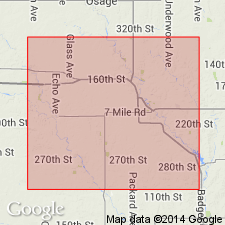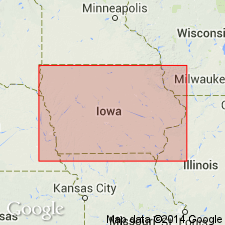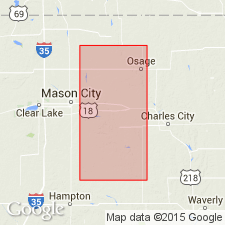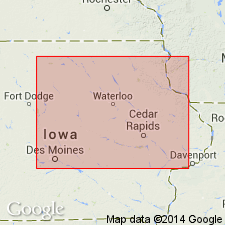
- Usage in publication:
-
- Nora limestone substage
- Modifications:
-
- Named
- Dominant lithology:
-
- Limestone
- AAPG geologic province:
-
- Iowa shelf
Summary:
Pg. 459. A new substage, for which Nora limestone is proposed, is added as lowest member of Lime Creek stage. Unconformably overlies Cedar Valley stage in Floyd County.
Source: US geologic names lexicon (USGS Bull. 896, p. 1506).

- Usage in publication:
-
- Nora substage
- Modifications:
-
- Redefined
- AAPG geologic province:
-
- Iowa shelf
Summary:
Redefined Nora substage of Shell Rock stage to include at base the uppermost part (First ACTINOSTROMA zone) of Mason City limestone of previous reports. He divided his Nora substage into (descending) Second ACTINOSTROMA zone, PLATYRACHELLA zone, First ACTINOSTROMA zone, and described it as consisting of 0-20 feet of hard white stromatoporoidal limestone, mag. shale, shaly limestone, and (in northern phases) dolomite.
Source: US geologic names lexicon (USGS Bull. 896, p. 1507).

- Usage in publication:
-
- Nora limestone
- Modifications:
-
- Overview
- AAPG geologic province:
-
- Iowa shelf
Summary:
According to C.L. Fenton (Amer. Jour. Sci., 4th ser., v. 48, 1919) this limestone possibly belongs to Cedar Valley limestone. In 1924 (Michigan Univ., Mus. Geol. Contributions, v. 1, frontispiece) C.L. Fenton and M.A. Fenton [or C.L. Fenton and C.L. Webster?] divided the Cedar Valley into (descending) Nora, Shell Rock, and Lower Cedar Valley.
Source: US geologic names lexicon (USGS Bull. 896, p. 1507).

- Usage in publication:
-
- Nora member
- Modifications:
-
- Overview
- AAPG geologic province:
-
- Iowa shelf
Summary:
Pg. 182 (table), 187. Shellrock [Shell Rock] consists of lithographic and dolomitic limestones and thin shales; includes (ascending) Mason City, Rock Grove, and Nora members.
Source: US geologic names lexicon (USGS Bull. 1200, p. 2760).

- Usage in publication:
-
- Nora Member
- Modifications:
-
- Overview
- AAPG geologic province:
-
- Iowa shelf
Summary:
Is the upper member of the Shell Rock Formation, upper formation which is one of four formations of the Cedar Valley Group (revised). Overlies Rock Grove Member of Shell Rock. Is characterized by prominent stromatoporoid biostromes separated by intervening shale or argillaceous skeletal calcilutite. Becomes more dolomitic, less shaly, and contains fewer stromatoporoids to west and southwest. Locally has "birdseye"-bearing and intraclastic beds. Where capped by Lime Creek Formation, it ranges from 3-7 m thick. Nomenclature charts, graphic sections. Name used in northern IA on the Iowa shelf. Of Late Devonian, Frasnian age.
Source: GNU records (USGS DDS-6; Denver GNULEX).
For more information, please contact Nancy Stamm, Geologic Names Committee Secretary.
Asterisk (*) indicates published by U.S. Geological Survey authors.
"No current usage" (†) implies that a name has been abandoned or has fallen into disuse. Former usage and, if known, replacement name given in parentheses ( ).
Slash (/) indicates name conflicts with nomenclatural guidelines (CSN, 1933; ACSN, 1961, 1970; NACSN, 1983, 2005, 2021). May be explained within brackets ([ ]).

